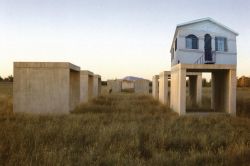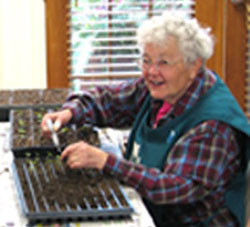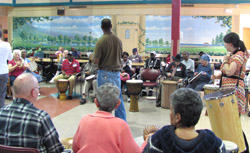As the baby-boomer population all reach the age of retirement, many older individuals are going to be forced into assisted living facilities. This article featured on PlaceMakers by Ben Brown highlights the ElderSpirit Community in Abingdon, VA, which on a relatively small budget, has created a community for older individuals that emphasizes people, skills, and needs.
"Among the Big Issues awaiting communities after we shake off the post-recession blues is what to do about demography. Particularly the part about America’s aging population.
The first-borns among the 76-million-strong Baby Boomer generation reached 65 in 2011. And over the next three decades, the geezer slice of the population pie will swell to 20 percent, compared to a little more than 13 percent in 2010. Take a look at the chart below, compiled from Census projections and pulled from the informative Alliance for Aging site.
That’s more than 88 million folks 65-plus, with the fastest growing cohorts the “oldest-old” segments of 80-plus.
I have a special interest in this topic, given that I’m among those leading-edge Boomers who have reconfigured commerce and culture to suit our tastes over the last half-century. It’s been a great run.
By now, just about everybody not invited to our long-running generational fiesta is tired of indulging Boomer fantasies. Sorry. Since we’re still running lots of stuff and still hoarding most of America’s financial assets, there’s more to come. Currently, we’re in the middle of one of our periodic – and probably our last – reality denial exercises. This is the one where we’re pretending Big Pharma, robots, electric cars and Dr. Oz will extend our playtime into infinity. You know, “60 is the new 40.” Unlike previous Boomer reality ducks, however, this one is going to be tough to buy or lie our way out of....."
Read More.
Read more »
 Photo Credit: Alan Rosenblum Photo Credit: Alan Rosenblum
Courtesy of Estudio Teddy Cruz
Home to the nation’s busiest United States-Mexico border crossing, San Ysidro is a suburb of San Diego, California, that lies just north of Tijuana, Mexico. Comprising mostly third- to first- generation immigrants, San Ysidro is often ignored, viewed as a place to pass through on the way to and from the border. Many San Ysidro-Tijuana families live in a bi-national condition, a state of being that finds families, work, education, affordable housing, health care, and economies tied to one another, and one that is currently struggling with the hot spots of drug cartel violence. Casa Familiar, a San Ysidro-based nonprofit organization, is working to invigorate the community by advocating for and assisting the residents in such areas as immigration services, education, and job placement[i].
 photo credit National Senior Games AssociationThe Good Life Games of Pinellas County encourage adults 50 and over to participate in their own “Senior Olympics,” to promote athleticism and healthy lifestyles. Many older adults are intimidated by the idea of athletic competition, out of fear that an injury or lameness could permanently limit their mobility. Specifically designed to meet the physical capabilities of older adults, the Olympic-style games include archery, track and field, swimming, cycling, and others. Players in Good Life Games are also eligible for statewide and national competitions. photo credit National Senior Games AssociationThe Good Life Games of Pinellas County encourage adults 50 and over to participate in their own “Senior Olympics,” to promote athleticism and healthy lifestyles. Many older adults are intimidated by the idea of athletic competition, out of fear that an injury or lameness could permanently limit their mobility. Specifically designed to meet the physical capabilities of older adults, the Olympic-style games include archery, track and field, swimming, cycling, and others. Players in Good Life Games are also eligible for statewide and national competitions.
Read more »
 photo credit Cheyenne Botanic Gardens photo credit Cheyenne Botanic Gardens
“The process of working in the Garden has a therapeutic effect: as the plants grow, so does the self-esteem of the older adult volunteers.”—Director, Cheyenne Botanic Gardens
The Cheyenne Botanic Gardens are unique not only for their use of solar and wind energy to enhance sustainability, but also because of their workforce, in which many volunteers are older adults, individuals with disabilities, and at-risk youth. According to Gardens staff, 90 percent of the physical labor is done by volunteers. The Gardens are an invaluable resource to the Cheyenne community, offering all the attractions of a beautiful environment, as well as occasions for structured, meaningful, and healthful activity for members of the community.
Read more »
 photo credit Wartburg Council for Creative Aging photo credit Wartburg Council for Creative Aging
The Wartburg Adult Care Community (The Wartburg) is a nonprofit organization dedicated to nurturing the mind, body, and spirit of older adults. Since its founding in 1899, The Wartburg has offered a continuum of care at its Mt. Vernon campus, and provides outreach to local parishes, senior centers, and civic organizations. In 2010, The Wartburg received a grant to enlist the aid of Lifetime Arts, which consults with many organizations on the design and implementation of creative aging programs and is led by a teaching artist. Lifetime Arts completed a survey of the Wartburg’s senior residents and staff, designed to gauge their interest in the arts. The findings were clear—residents and staff desired more arts and cultural programming.
In 2011, The Wartburg Council for Creative Aging was established to allow its nearly 500 senior residents in the assisted living, memory care, skilled nursing residence, and adult day programs to express themselves through art, song, theater, poetry, and oral histories. In difficult financial times, launching the Council required some creativity. Fortunately, the Council discovered a unique method for both cutting costs and serving the community; The Wartburg’s common rooms were vacant at night, while artists in the community were paying high rents for studio space. Ann Frey, the director of the Council, began recruiting teaching artists to use The Wartburg’s space in the evening as art studios, free of rent. In exchange, the artists were asked to teach classes to the older adult residents.
Read more »
|
|